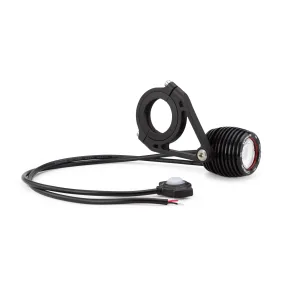Electric Bike Lights
Electric lights for electric bikes play a crucial role in ensuring safety, visibility, and functionality for riders, especially during low-light conditions or at night. These lights are designed to provide illumination for the rider, enhance visibility for other road users, and comply with legal requirements for bike lighting. Here’s a brief overview of electric lights for electric bikes:
READ MORE...Types of Lights:
Front Lights (Headlights): Front lights are mounted on the handlebars and are essential for illuminating the path ahead. They come in various brightness levels and beam patterns to offer a clear view of the road.
Rear Lights (Taillights): Rear lights are typically mounted on the seat post or rear rack. They emit a red light to alert vehicles and pedestrians behind the rider.
Integrated Lights: Some electric bike models come with built-in lights that are seamlessly integrated into the frame or components.
Additional Lights: Some riders opt for additional lights, such as wheel lights, side visibility lights or helmet lights, to enhance their overall visibility.
Power Source:
Battery-Powered Lights: Many electric bike lights are powered by rechargeable batteries, either integrated into the light unit or detachable for charging.
Dynamo-Powered Lights: In some cases, lights can be powered by a dynamo hub that generates electricity as the bike is in motion, offering a sustainable and continuous power source.
Brightness and Beam Patterns:
Lights for electric bikes come in varying levels of brightness, typically measured in lumens. Higher lumens provide brighter illumination but may consume more power.
Beam patterns also vary, with options like focused beams for distance vision and wider beams for increased peripheral visibility.
Mounting and Adjustability:
Lights can be easily attached and adjusted on the bike’s handlebars, seat post, fork, or other suitable locations.
Some lights come with adjustable angles and quick-release mechanisms for ease of use.
Visibility Modes:
Most lights offer different modes, such as steady, flashing, or pulsating, to suit different riding conditions and conserve battery life.
Legal Requirements:
Different regions have specific regulations regarding bike lighting. Electric bike riders need to ensure their lights meet local requirements for visibility and safety.
Weather Resistance:
Lights designed for electric bikes often come with weather-resistant or waterproof features to withstand various weather conditions.
Accessories and Compatibility:
Many lights can be paired with additional accessories like mounts, extension cables, or remotes to enhance functionality and convenience.
Safety and Visibility:
Electric bike lights greatly enhance the rider’s safety by making them visible to other road users, especially at dusk, dawn, and night.
When choosing electric lights for your electric bike, consider your riding conditions, local regulations, and the level of visibility you need. High-quality lights contribute to a safer and more enjoyable riding experience, allowing you to confidently navigate roads in various lighting conditions.




